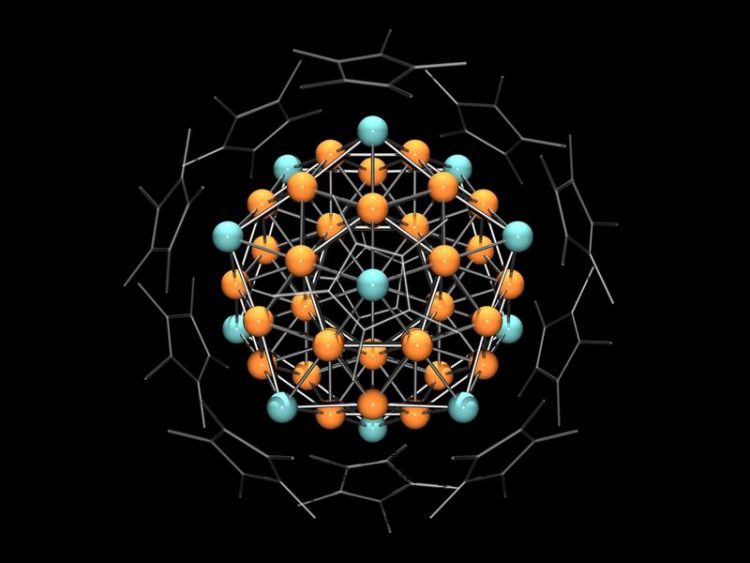Copper-aluminum superatom

43 copper and 12 aluminum atoms form a cluster that has the properties of an atom. The heterometallic superatom is the largest ever produced in the laboratory. Christian Gemel / TUM
Chemistry can be expensive. For example, platinum is used to clean exhaust gases. This precious metal acts as a catalyst which speeds up chemical reactions. Without catalysts, it would not be possible to carry out a large number of processes in the chemical industry.
“Many groups of researchers are experimenting with new material compounds made of lower-cost base metals such as iron, copper, or aluminum. However, so far nobody has been able to predict whether, how, and why these catalysts react”, explains Roland Fischer, Professor for Inorganic and Metal-Organic Chemistry at the TUM. “Our goal was to bridge this gap and to create the basis for understanding a new generation of catalysts.”
Bottom-up approach yields results
Together with his team, the chemist has now uncovered a secret of base metal compounds. “What was new about our approach was that we did not examine existing materials, but instead went bottom-up and built compounds made of individual copper and aluminum atoms”, explains Fischer.
Combining two metals at the atomic level requires no small amount of know-how and finesse: Within a protective argon atmosphere, the chemists combined the metal atoms which were bound to organic compounds in a test tube, to which they then added a solvent.
“Naturally, we hoped that the copper and aluminum atoms would separate from the organic compounds and form a cluster together. But whether they would actually do that and what the result would be was entirely unclear”, remembers Fischer.
The secret of the crystals
Hence, the chemists were extremely delighted to find that reddish-black particles with a diameter of up to one millimeter had formed at the bottom of the test tube. X-ray images revealed an extremely complex structure: In each case, 55 copper and aluminum atoms were arranged such that they formed a crystal whose surface consisted of 20 equilateral triangles.
Crystallographers call such shapes icosahedrons Additional experiments showed that chemically, the crystals react like an individual copper atom and are also paramagnetic, which means that they are attracted by a magnetic field.
An explanation for the extraordinary properties of the metal clusters was provided by Prof. Jean-Yves Saillard from the French university in Rennes: According to him, 43 and 12 aluminum atoms organize themselves into a “superatom” in which the metals form a shared electron shell which resembles that of a single metal atom.
Hence, the cluster has the chemical properties of an atom. Located on the outermost shell are three valence electrons whose spins align themselves in a magnetic field — hence the observed paramagnetism.
Knowledge base for new catalysts
The heterometallic superatom by the researchers in Munich is the largest one ever made in the lab. “That it formed spontaneously, i.e. without the input of energy, out of a solution is an extremely remarkable outcome”, emphasizes Fischer. “It shows that the arrangement of 55 atoms constitutes an island of stability and hence determines the direction in which the chemical reaction takes place.”
The researchers now intend to use the findings of the research project to develop fine-grained and hence highly effective catalyst materials. “We are still far away from being able to use it in applications”, emphasizes Fischer. “But based on what we have now achieved, we can verify the suitability of copper-aluminum clusters for catalytic processes and also create clusters made of other promising metals.”
Further information:
The project was funded by the German Research Foundation (DFG), the Alexander von Humboldt Foundation, and the German Chemical Industry Fund (FCI). Computing time was provided by the French Supercomputing Center GENCI.
Publication:
Jana Weßing, Chelladurai Ganesamoorthy, Samia Kahlal, Rémi Marchal, Christian Gemel, Olivier Cador, Augusto C.H. Da Silva, Juarez L. F. Da Silva, Jean-Yves Saillard and Roland A. Fischer:
The Mackay-type cluster [Cu₄₃Al₁₂](Cp*)₁₂: Open-shell 67electron superatom with emerging metal-like electronic structure;
Angew. Chem. Int. Ed. 07/2018. DOI: 10.1002/anie.201806039
Prof. Dr. Roland Fischer
Technical University of Munich
Chair of Inorganic and Metal-Organic Chemistry
Tel.: +49 89 289 13080 – E-mail: roland.fischer@tum.de
https://onlinelibrary.wiley.com/doi/abs/10.1002/anig.201806039
https://www.tum.de/nc/en/about-tum/news/press-releases/detail/article/34960/ press release on TUM website
https://mediatum.ub.tum.de/1455514 High resolution images
http://www.amc.ch.tum.de Website of the Chair of Inorganic and Metal-Organic Chemistry
Media Contact
All latest news from the category: Life Sciences and Chemistry
Articles and reports from the Life Sciences and chemistry area deal with applied and basic research into modern biology, chemistry and human medicine.
Valuable information can be found on a range of life sciences fields including bacteriology, biochemistry, bionics, bioinformatics, biophysics, biotechnology, genetics, geobotany, human biology, marine biology, microbiology, molecular biology, cellular biology, zoology, bioinorganic chemistry, microchemistry and environmental chemistry.
Newest articles

Superradiant atoms could push the boundaries of how precisely time can be measured
Superradiant atoms can help us measure time more precisely than ever. In a new study, researchers from the University of Copenhagen present a new method for measuring the time interval,…

Ion thermoelectric conversion devices for near room temperature
The electrode sheet of the thermoelectric device consists of ionic hydrogel, which is sandwiched between the electrodes to form, and the Prussian blue on the electrode undergoes a redox reaction…

Zap Energy achieves 37-million-degree temperatures in a compact device
New publication reports record electron temperatures for a small-scale, sheared-flow-stabilized Z-pinch fusion device. In the nine decades since humans first produced fusion reactions, only a few fusion technologies have demonstrated…





















